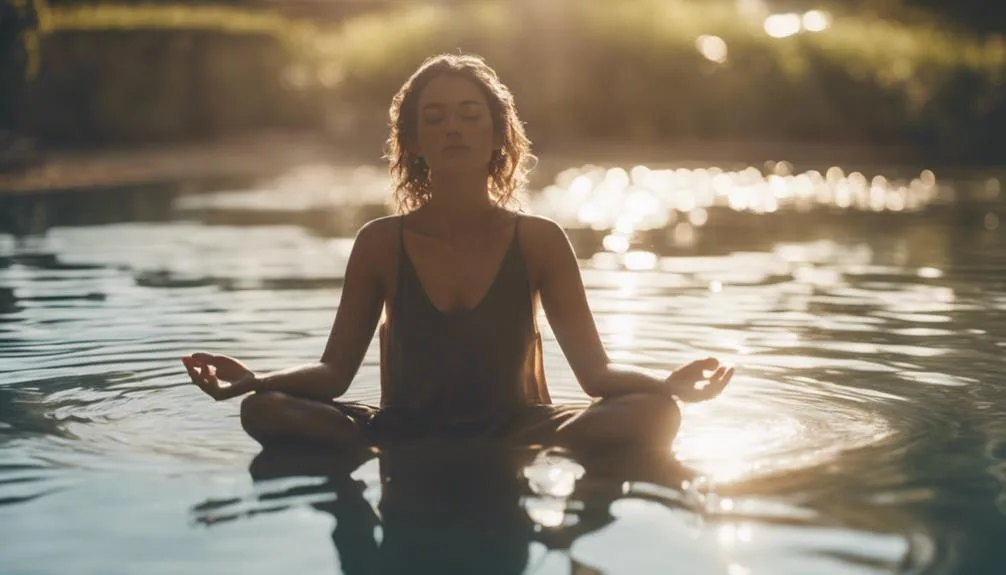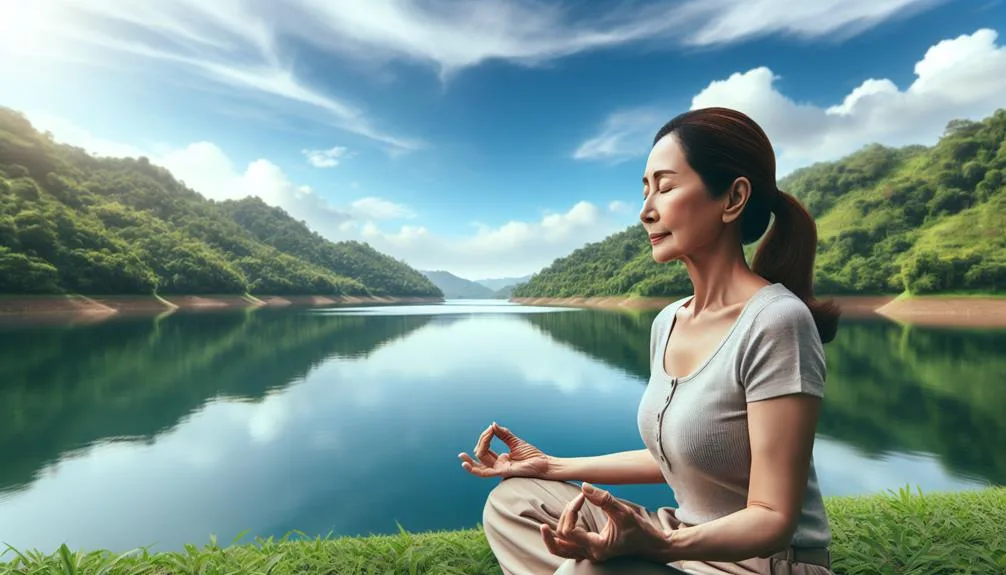Exploring the depths of meditation through water techniques offers a unique avenue for cultivating tranquility and mindfulness. The gentle flow of aquatic elements presents a serene backdrop for inner reflection and relaxation.
As we navigate the soothing waters of meditative practices, we uncover a profound connection between our inner state and the fluidity of the environment.
Stay tuned to discover how water meditation methods can guide us towards a heightened sense of peace and self-awareness, paving the way for a harmonious union between mind, body, and spirit.
Key Takeaways
- Water meditation offers unique sensory experiences for enhanced mindfulness.
- Incorporate water sounds or meditate in water for a calming and immersive practice.
- Experiment with different water environments for varied meditative experiences.
- Use water meditation as a tool to deepen relaxation and focus during mindfulness sessions.
Water Sounds Meditation Techniques
When seeking tranquility through meditation, utilizing water sounds can provide a soothing and immersive experience for practitioners.
Ocean wave meditation and river stream mindfulness are popular techniques that harness the calming effect of water.
By listening to audio tracks of water sounds with headphones, individuals can enhance their focus during meditation sessions.
Practitioners are encouraged to concentrate on these sounds while engaging in deep breathing or a body scan to deepen the meditative experience.
Visualizing oneself surrounded by water further amplifies the sense of peace and relaxation.
Incorporating water sounds into meditation can create a serene environment conducive to mindfulness and inner peace.
Meditating in Water
Consider immersing yourself in the practice of water meditation to explore a unique and refreshing way to enhance your mindfulness journey. Floating meditation allows you to experience new sensations and awareness while connecting with the element of water.
Whether you start in a shallow pool or with your feet in a stream, there are no special requirements for this practice. Experiment with increased mindfulness in the pool, paying attention to how your body feels and the thoughts that arise.
Additionally, engaging in ocean mindfulness can provide a deeper connection with nature and a sense of tranquility. Embrace the opportunity to meditate in various water environments, allowing the calming properties of water to guide you towards inner peace and serenity.
Practicing Water Meditation

Embark on your water meditation journey to discover a profound sense of mindfulness and serenity through the practice of immersing yourself in various water environments. Here are some ways to enhance your water meditation experience:
- Ocean Mindfulness: Close your eyes and listen to the rhythmic waves, focusing on each breath as the tide ebbs and flows.
- River Serenity: Sit by a gentle river, observing the smooth flow of water, allowing it to carry away any tension or worries.
- Lake Tranquility: Find a peaceful spot by the lake, feeling the stillness of the water mirror the calmness within you.
- Waterfall Meditation: Stand near a waterfall, letting the sound of cascading water wash away distractions, bringing clarity to your mind.
Immerse yourself in the beauty of water and let it guide you towards inner peace and mindfulness.
Pool Meditation Practices
Immerse yourself in the tranquil practice of pool meditation to cultivate a sense of calm and introspection amidst the soothing embrace of water.
In the pool, find a shallow area to sit or float, allowing the water to support your body weight and encourage relaxation. Avoid distractions from floatation devices to fully engage in the experience.
Take a moment to notice the floating reflections on the water's surface and the tranquil depths below, enhancing your sense of peace and connection. Let the gentle movements of the water guide your thoughts as you experiment with mindfulness in different water settings.
Pool meditation offers a unique perspective and a serene environment for self-reflection and inner peace.
Shower Meditation Tips

Enhance your daily shower routine by incorporating mindfulness with these practical Shower Meditation Tips.
- Rainy Day Reflections: Imagine the water cascading down like rain, washing away stress and tension, leaving you refreshed and renewed.
- Ocean Waves Visualization: Close your eyes and envision the rhythmic sound of ocean waves, allowing their calming energy to flow over you.
- Temperature Awareness: Focus on the sensation of the water temperature, feeling each droplet as it touches your skin, bringing you into the present moment.
- Slow Down and Breathe: Take slow, deep breaths as you shower, letting go of worries with each exhale, and embracing a sense of peace and tranquility.
Frequently Asked Questions
How Can Water Meditation Help With Managing Stress and Anxiety?
Water meditation aids in stress relief by connecting mind and body, enhancing emotional well-being. Relaxation techniques through water sound immersion and mindful practices in water environments help manage stress and anxiety, fostering a serene state.
Are There Any Specific Breathing Techniques That Can Be Incorporated Into Water Meditation?
In water meditation, deep breathing techniques can enhance mindfulness, relaxation, and focus. Incorporate slow, deliberate breaths to sync with the water's rhythm, promoting a calming and immersive experience. Practice with intention and openness.
Can Water Meditation Be Beneficial for Individuals With Chronic Pain or Physical Discomfort?
Water meditation can provide pain relief and aid in physical therapy for those with chronic pain. The gentle embrace of water can soothe discomfort, offering a serene sanctuary for healing and relaxation.
Is There a Recommended Duration for Water Meditation Sessions to Fully Experience Its Benefits?
To fully experience the benefits of water meditation and enhance the mind-body connection for healing, an optimal duration of 20-30 minutes is recommended. Engaging in this practice regularly can promote relaxation, clarity, and overall well-being.
How Can Individuals With Limited Access to Natural Bodies of Water Incorporate Water Meditation Into Their Daily Routine?
Individuals with limited access to natural bodies of water can incorporate water meditation into their daily routine by exploring indoor alternatives like meditating in a bathtub or using visualization techniques. Embrace mindful movement and creative rituals to enhance the experience.
Conclusion
In conclusion, exploring water meditation techniques can lead to a deeper sense of inner peace and mindfulness. By immersing oneself in aquatic environments or simply listening to water sounds, individuals can enhance their focus and overall well-being.
Remember, as the saying goes, 'still waters run deep,' encouraging us to dive into the depths of our consciousness and discover the tranquility that water meditation can offer.
Embrace the serenity of water to unlock a profound connection to the self.

